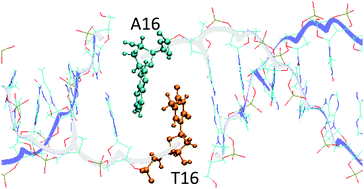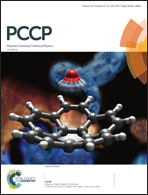Stability of radiation-damaged DNA after multiple strand breaks†
Abstract
Damage to the DNA backbone occurs from natural sources, and with exceedingly large density during radiotherapy, as typically used for cancer treatment. Here, we focus on the molecular-scale dynamics of the events immediately following the production of single- and double-strand breaks, since this early-stage evolution of the damage is crucial to determine the subsequent fate of the DNA fragment. While multiple cleavage of phosphodiester bonds is the first step, however the remaining hydrogen-bond and π-stacking interactions maintain a considerable DNA cohesion, and determine further defect evolution. We use all-atom molecular dynamics to simulate the force spectra and thermal stability of different single- and multiple-defect configurations, in a random 31 bp DNA sequence. Simulations reveal a complex dynamical behaviour of the defects, where collective bond-rearrangement phenomena dominate with respect to simple bond cleavage. Defects are stable against thermal disruption, unless very closely spaced. We establish the necessary conditions for the events ultimately leading to DNA fragmentation. Such findings impact the early stages of damage recognition and signalling by specialised proteins, also implying that the identification and counting of DSBs by different experimental methods is non-unique.



 Please wait while we load your content...
Please wait while we load your content...